SaaS OKRs: Examples & Frameworks for Product-Led Growth
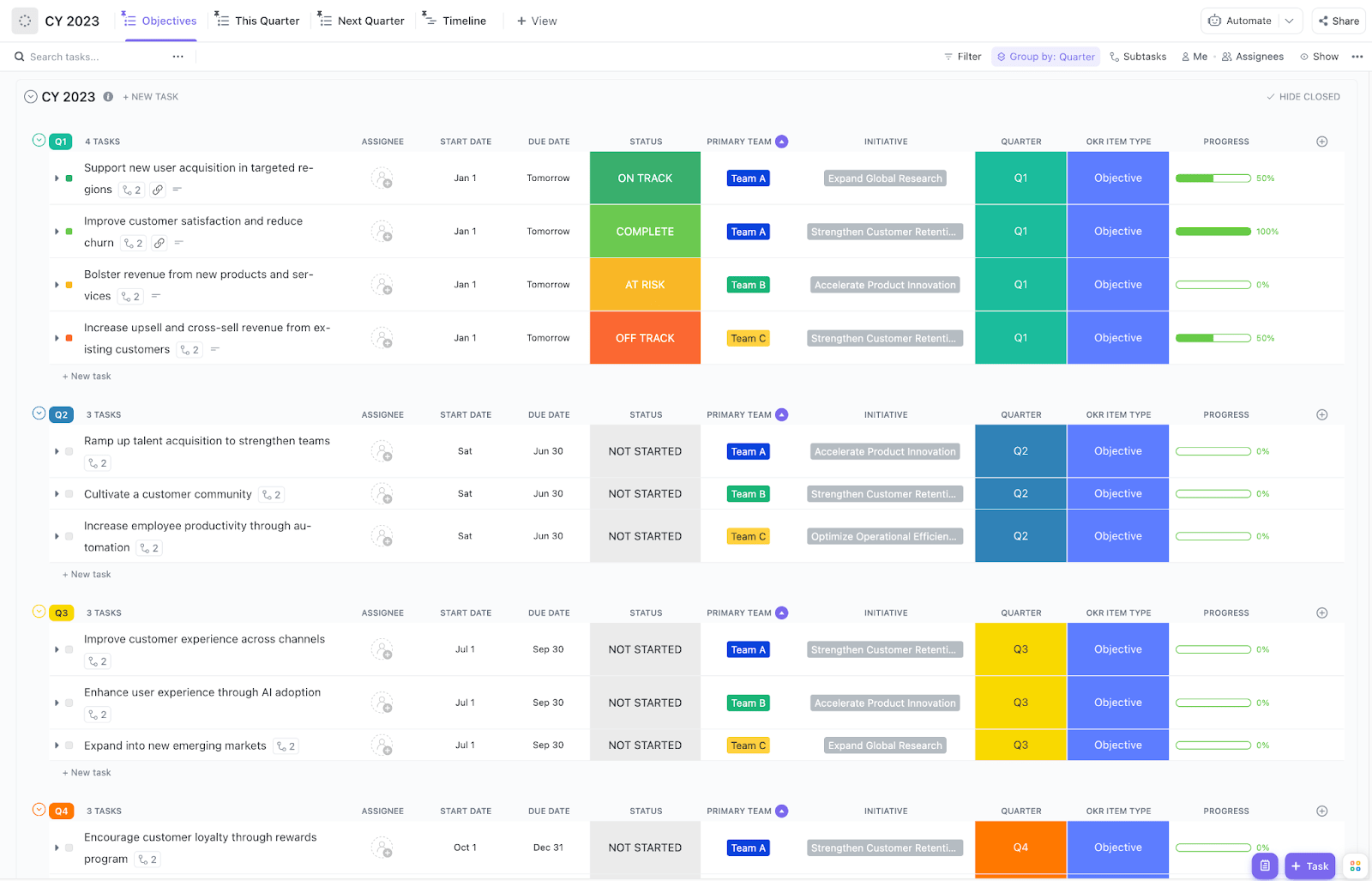
Sorry, there were no results found for “”
Sorry, there were no results found for “”
Sorry, there were no results found for “”

At the end of Q2, the sales team missed its target by 6%. Not catastrophic, but enough to sting. And when you rewind, it wasn’t about effort. People were working hard… just not on what mattered most.
OKRs—Objectives and Key Results—exist to fix that. They align work to strategy, connect goals across teams, and bring urgency to progress. But when they’re vague, disconnected, or tracked in five different tools? They become just another task to check off.
In this blog post, we’ll explore everything you need to know about OKRs and how ClickUp helps you track them. 🎯
A simple goal-setting framework built for high-velocity teams.
OKRs (Objectives and Key Results) help you define what you want to achieve—and how you’ll know you’re getting there. In fast-moving SaaS orgs, they help you stay laser-focused even when priorities shift weekly.
✅ Objective: Clear, inspiring outcome
✅ Key Results: Measurable proof you’re making progress
Things move fast in SaaS companies: shifting markets, growing teams. Without a clear roadmap, it’s easy to get busy but not necessarily effective.
Here’s how OKRs help:
📕 Glossary: Monthly Recurring Revenue (MRR) refers to the predictable income your business earns each month from subscriptions or recurring billing, enabling you to measure steady growth. Customer Acquisition Cost (CAC) refers to the amount spent to acquire each new customer, encompassing marketing, sales, and onboarding expenses.
Looking for an OKR software that actually helps you set, track, and hit goals? This video breaks down the top goal-setting tools, including what they do best, what trade-offs to consider, and which ones fit your team’s size and stage.
In SaaS organizations, goals can quickly become moving targets. A well-structured OKR framework brings consistency to that change, allowing teams to prioritize the right initiatives, course-correct early, and reflect on impact.
Let’s walk through how to set and implement OKRs. 💁
💡 Anchor every objective to your company’s mission to keep teams aligned.
Before you dive into setting goals, take a step back. Every objective should reflect your company’s vision and strategic priorities. If an OKR doesn’t directly support the ‘why’ behind your business, it’s noise.
📌 Example: Your mission is to ‘simplify SaaS tools for freelancers.’ A strong objective might be ‘Launch an intuitive dashboard experience tailored for solo users.’
💡 Make your objectives short, motivating, and free of metrics.
Your objective is the destination, not the map. It should be short, motivating, and free of metrics. Avoid packing in how-to steps or KPIs; that’s what key results are for.
If your objective doesn’t energize the team, rewrite it. You’ll revisit this line every week, so you must make it count.
⚠️ Watch out: ‘Improve conversion rates by 2% by optimizing landing pages’ is not an objective. That’s a key result wrapped in a to-do list. A better objective is ‘Deliver a smooth first-time experience for users.’
💡 Turn intentions into measurable outcomes.
Key results are where the accountability lives. They tell you whether you’re making progress. Each one should be a quantifiable outcome, not a vague intention or activity.
📌 Example: Objective: ‘Improve user retention in the first 30 days.’
Key results:
💡 Fewer, sharper goals beat scattered priorities.
More isn’t better; better is better. SaaS teams are already balancing feature releases, roadmap changes, customer feedback, and fire drills. Stick to 2-4 measurable objectives per team, each with 3-5 key results max.
Additionally, ensure that each team’s objectives support both the broader company goals and those of other teams.
📌 Example:
💡 OKRs evolve with you—check in, score, and refine.
OKRs aren’t ‘set and forget.’ Check in weekly or biweekly, not to assign blame, but to course-correct. Use a simple 0.0-1.0 scoring system at the end of the cycle to accurately reflect progress.
A scoring system can look like:
Once you understand the OKR framework, the next step is applying it to your teams.
Below, we’ll explore real-world SaaS OKR examples by department, from Product and Engineering to Marketing and Customer Success, to help you set measurable goals that truly drive growth.
The most effective SaaS teams tie their daily work to broader SMART goals. Here, let’s break down practical OKR examples by team so that everyone can move in sync. 👇
You’re shipping quickly, but the customer churn rate remains high. That’s often a sign the product team is focusing on delivery over impact. Clear product OKRs centered around adoption, retention, or time-to-value can redirect efforts toward meaningful results.
Here are some examples of effective OKRs:
🔍 Did You Know? Andy Grove, a former CEO of Intel, first introduced OKRs as a concept in the 1970s. It was a growth and innovation management strategy that fit the company’s business model. His inspiration was the management theorist Peter Drucker and the management by objectives (MBO) concept.
It’s easy for engineering goals to get buried under tickets and technical debt. Here are some examples of OKRs that can help save you if you’re one of them.
Improve the quality of product releases
Speed up the development team
Your campaigns get clicks, but sales are still struggling with lead quality. This is where you need an effective OKR. Here are some examples of marketing OKRs for inspiration:
Improve marketing-sales alignment on lead quality criteria
Strengthen brand visibility and inbound growth
Sales teams thrive on targets, but sales OKRs help balance immediate revenue goals with long-term growth levers. Here are some examples:
Improve sales efficiency and close more high-quality deals
Build a repeatable and scalable outbound sales engine
📖 Also Read: SaaS Examples You Need To Know About
Customers onboard successfully, but drop off after three months. This points to weak value realization. OKRs around adoption milestones, health scores, or NPS can help CS teams step in before it’s too late. Here are some examples:
Increase customer satisfaction and loyalty
Keep more customers and lower churn
OKRs and KPIs are often confused, but they serve distinct purposes. While KPIs track the health of your business, OKRs push it forward. Understanding when to use each and how they can work together is key to building a high-performing SaaS team.
Let’s understand the differences between OKRs vs. KPIs.
| Criteria | OKRs | KPIs |
| Definition | A goal-setting method with clear business objectives and measurable results | Metrics that track how well the business is doing in certain areas |
| Purpose | Help teams stay focused and aligned on big-picture goals | Monitor performance and check if targets are being met |
| Scope | Broad and aspirational | Specific and focused on day-to-day operations |
| Time frame | Usually set for a quarter or a year | Tracked regularly: daily, weekly, monthly, or quarterly |
| Structure | One objective with 2-5 measurable key results | Single metrics or groups of related metrics |
| Change frequency | Reviewed and updated every quarter (or as needed) | Stay mostly the same to track trends over time |
| Example in SaaS | Objective: Improve retention. KR: Reduce churn from 5% to 3% this quarter | MRR, churn rate, CAC, customer LTV |
| Focus | What you want to achieve and how you’ll know if you’re getting there | How you’re doing in key business areas |
🧠 Fun Fact: While serving different purposes, both OKRs and KPIs stem from Drucker’s original work! However, the concept of KPIs dates back to the early 20th century, when Frederick Taylor, a pioneer in scientific management, introduced the use of data and measurement to enhance productivity. The term ‘Key Performance Indicator’ was coined later, after the MBO theory.
OKRs are the compass for your company. Done right, they align teams, sharpen focus, and keep your growth trajectory on track.
But tracking OKRs? That’s tricky. Here’s how to do it step-by-step with ClickUp, the everything app for work, so you don’t miss anything.
Start with the big picture. What are the 2-3 goals your company wants to achieve this quarter? These should reflect your strategic bets. This can include doubling down on a product launch, expanding into a new market, or fixing a churn spike.
Once you’ve figured that out, here’s what you need to do:
Once your top-level objectives are clear, you must translate them into trackable OKRs.
This is something ClickUp Goals makes remarkably easy. You can create both company-wide and team-specific OKRs in one central workspace. For each key result, link directly to the supporting ClickUp Tasks, ClickUp Docs, Dashboards, and even sprint cycles.
Say your leadership team sets a quarterly objective like ‘Increase product-led growth across self-serve channels.’ In ClickUp, you’d break this down into measurable KRs and tie it to live workflows, such as a user research document and a product analytics dashboard. You can assign owners, update statuses, and track how teams are spending their time on each task.
Here’s how one ClickUp customer, Spekit uses OKRs for transparency and alignment using ClickUp:
Organizational transparency is one of the most impactful benefits realized since rolling out ClickUp to the team.
Now, in ClickUp, anyone in the organization can see each of our team’s OKRs, who owns them, and their progress. Looking back now, before ClickUp, we didn’t have that level of transparency, so all of our departments were disconnected.
Now, it’s time to turn them from static goals to dynamic progress indicators. This only happens when you embed them into your team’s operating system.
Establish a weekly or bi-weekly rhythm where teams:
Use confidence scoring to identify issues early. For each key result, have owners rate their confidence (e.g., red, yellow, or green—or 1–5). This adds a predictive layer that goes beyond simply tracking percentage completion.
However, if you’re struggling to maintain this cadence consistency, turn to ClickUp Automations.
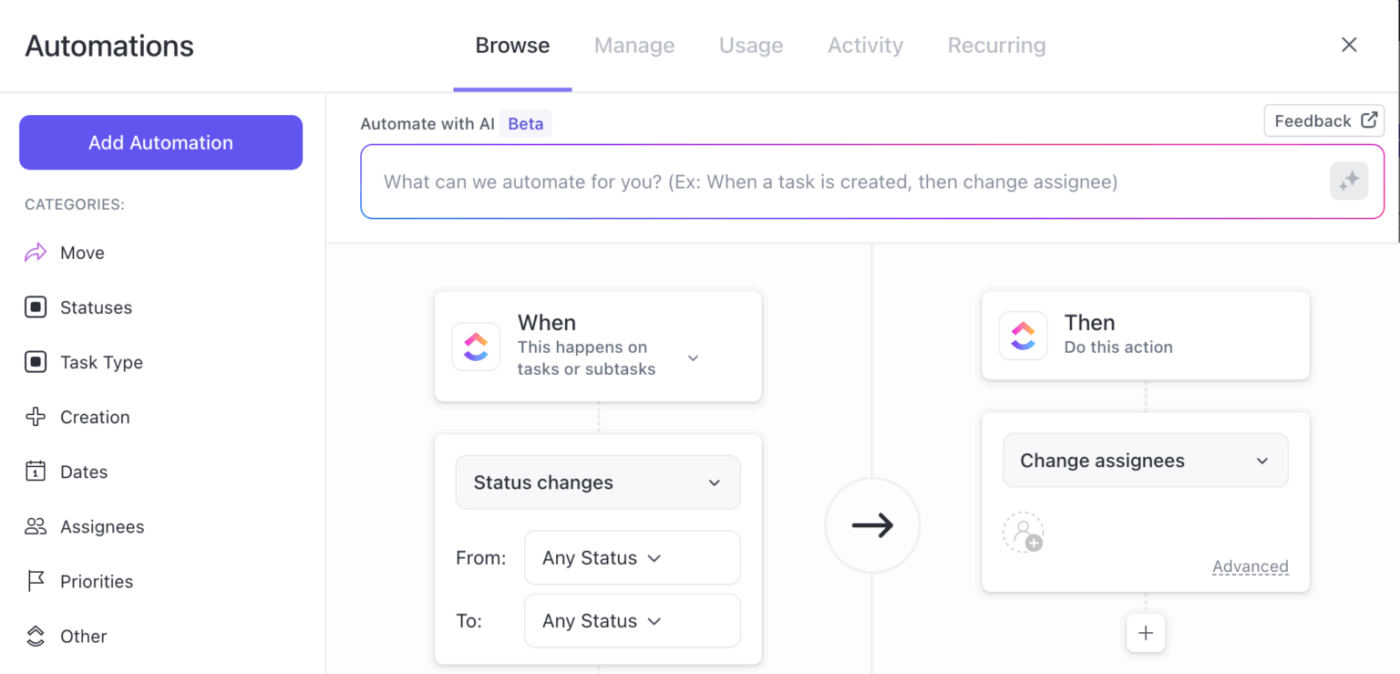
Let’s say your marketing team reviews OKRs every Monday at 10 am. You can set a custom automation that triggers every Monday morning to:
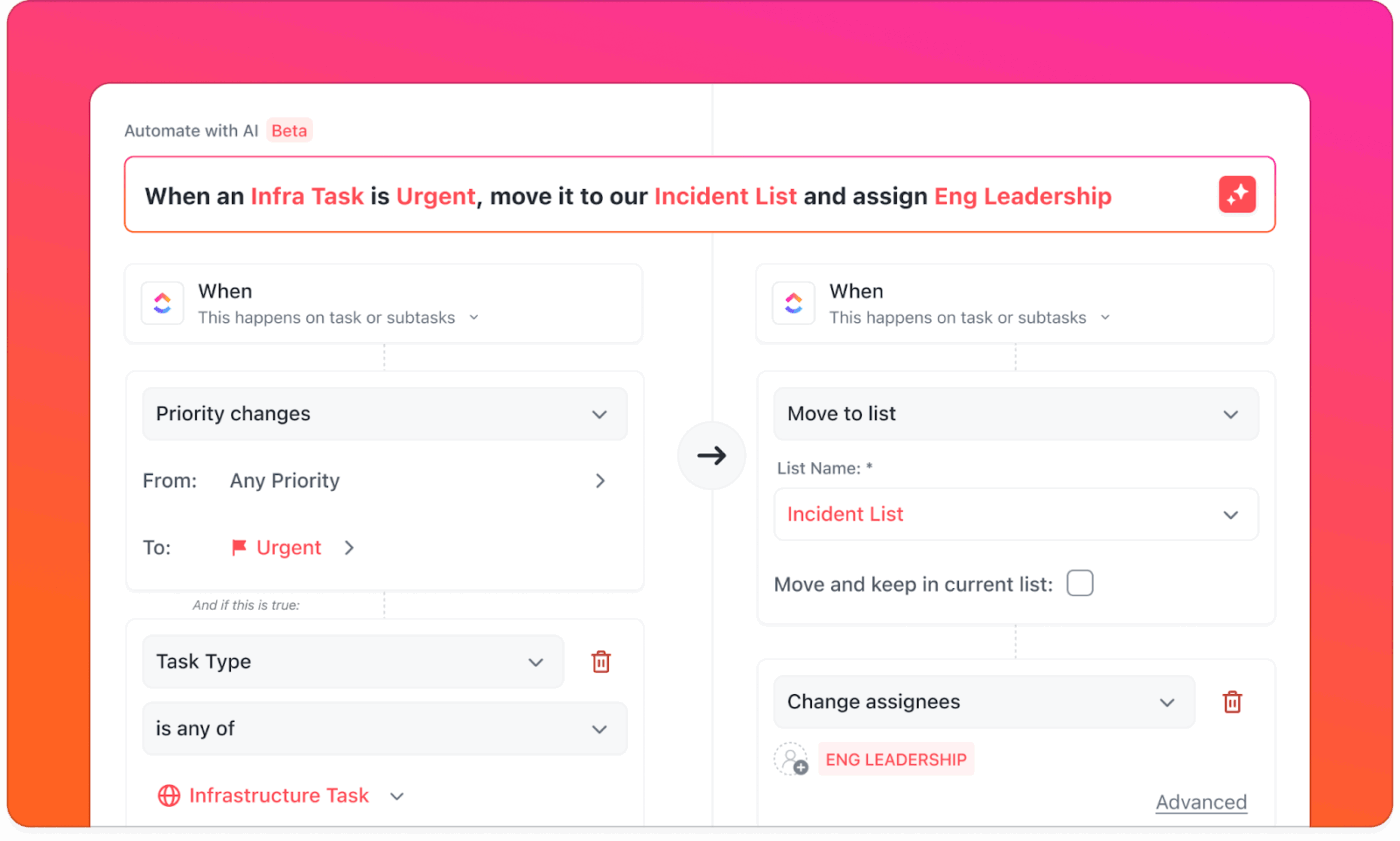
ClickUp Brain, the platform’s integrated AI-assistant, lets you set automations using natural language prompts. All you need to do is say, ‘Every Friday at 4 pm, remind all OKR owners to update their progress and confidence scores.’ It’ll build an automation for you without manual setup.
To create company-wide alignment, you must allow everyone to see everything. Create OKR dashboards that are visible to all teams, use them in all-hands meetings, and assign clear owners for each objective and key result.
ClickUp Dashboards are real-time, interactive control centers that enable anyone to track the business’s progress toward its goals.
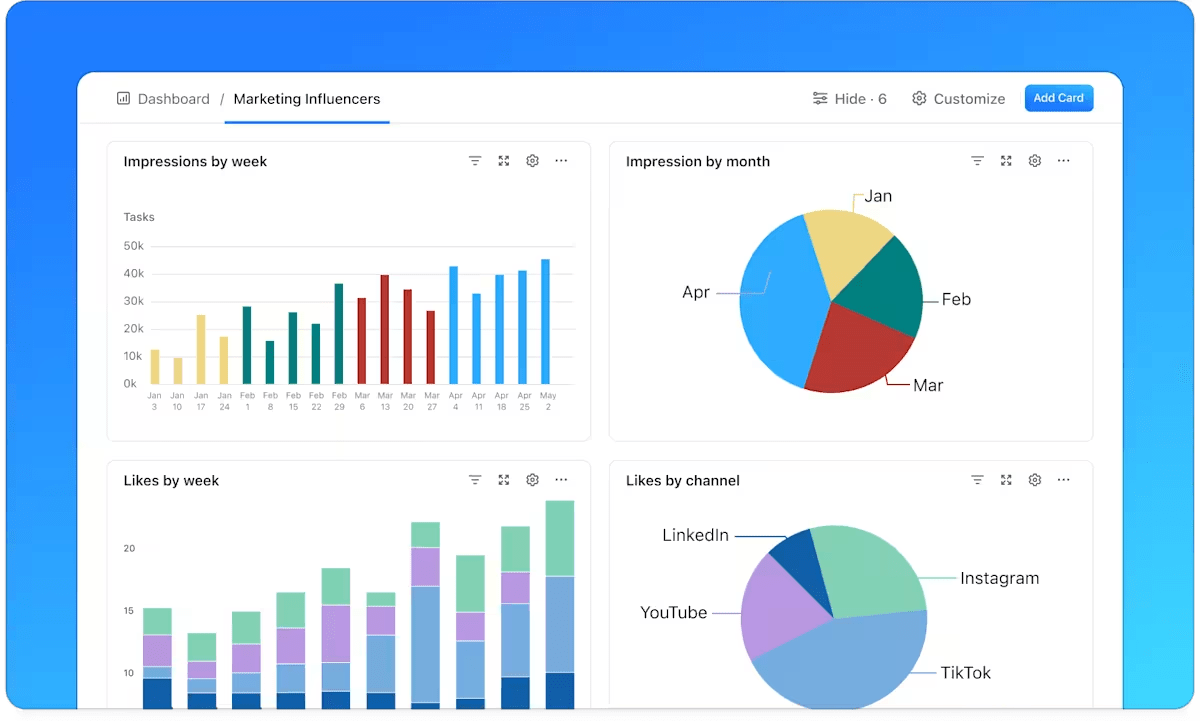
Each dashboard is composed of cards that retrieve live data from your workspace, such as at-risk key results, overdue tasks, or average completion rates by team. You can filter them by team, time, or priority to make it more actionable.
For instance, your sales team’s OKR is to increase quarterly revenue growth by 20%. Your ClickUp Dashboard can include:
With ClickUp Brain, you can generate automated, human-like progress updates directly from live data on your dashboard.
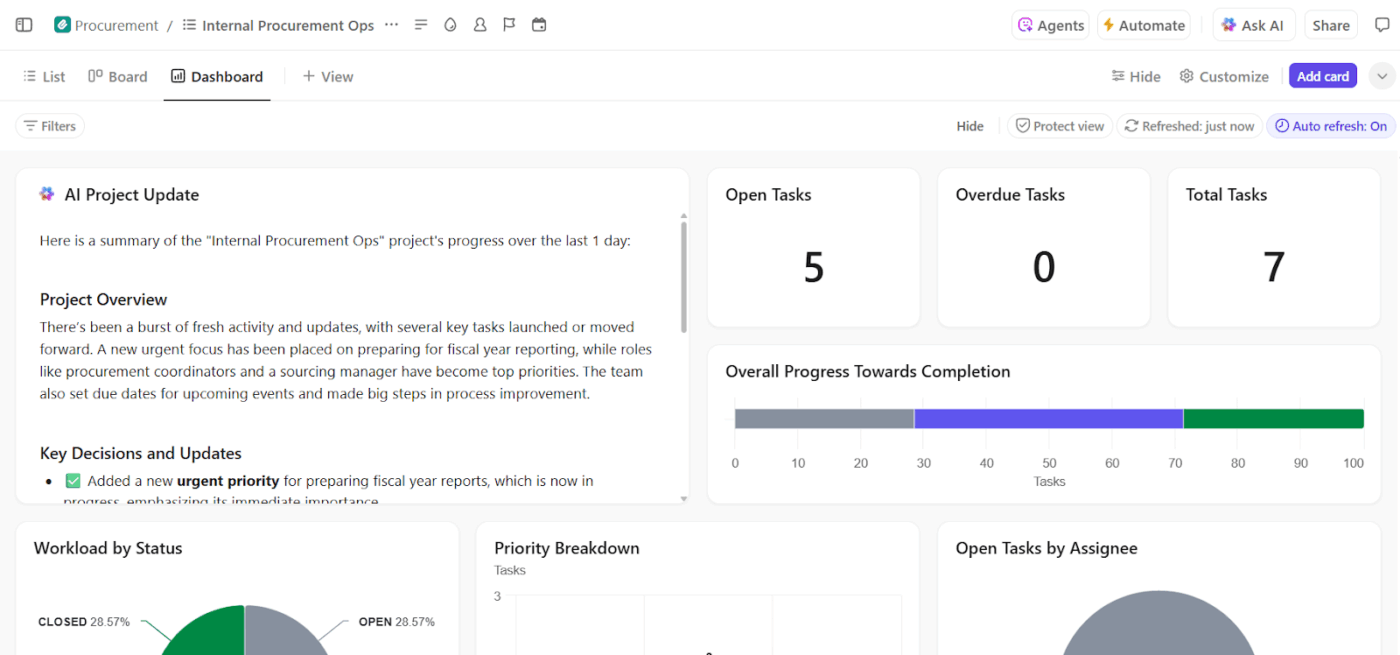
You don’t need to interpret charts or metrics manually. The AI Project Manager instantly summarizes your dashboard, highlighting key trends, wins, and bottlenecks.
This means:
📮 ClickUp Insight: 78% of our survey respondents make detailed plans as part of their goal-setting processes. However, a surprising 50% don’t track those plans with dedicated tools. 👀
With ClickUp, you seamlessly convert goals into actionable tasks, allowing you to conquer them step by step. Additionally, our no-code dashboards offer clear visual representations of your progress, highlighting your accomplishments and providing you with more control and visibility over your work. Because “hoping for the best” isn’t a reliable strategy.
💫 Real Results: ClickUp users say they can take on ~10% more work without burning out.
How ClickUp Brain Helps You Track and Improve OKRs Automatically
Manual goal updates eat into strategy time. ClickUp Brain, the AI engine behind the Converged AI Workspace, automates OKR upkeep, allowing teams to focus on outcomes rather than check-ins.
Additionally, use ClickUp Brain MAX with voice input to log OKR updates or reflections instantly—just talk, and it turns your words into structured text. During quarterly reviews, you can dictate progress notes or key insights, then let ClickUp Brain MAX summarize and cross-reference them across projects, Dashboards, and Docs.
Tie every key result to a metric that tells a story:
Then, watch for patterns: What’s moving the needle? What’s lagging? Use this insight to refine your OKRs for the next cycle.
Let’s say your company’s OKR is to improve user retention by 25%. Key results include reducing the churn rate by 15%, increasing the number of weekly active users by 20%, and launching three customer-requested features.

Here’s how the ClickUp Project Hierarchy helps:
Each task includes assignees, due dates, dependencies, and subtasks if needed. You can link them directly to the key results using Custom Fields, Goals, or even relationships. Create OKR templates of different workflows to ensure consistency every quarter.
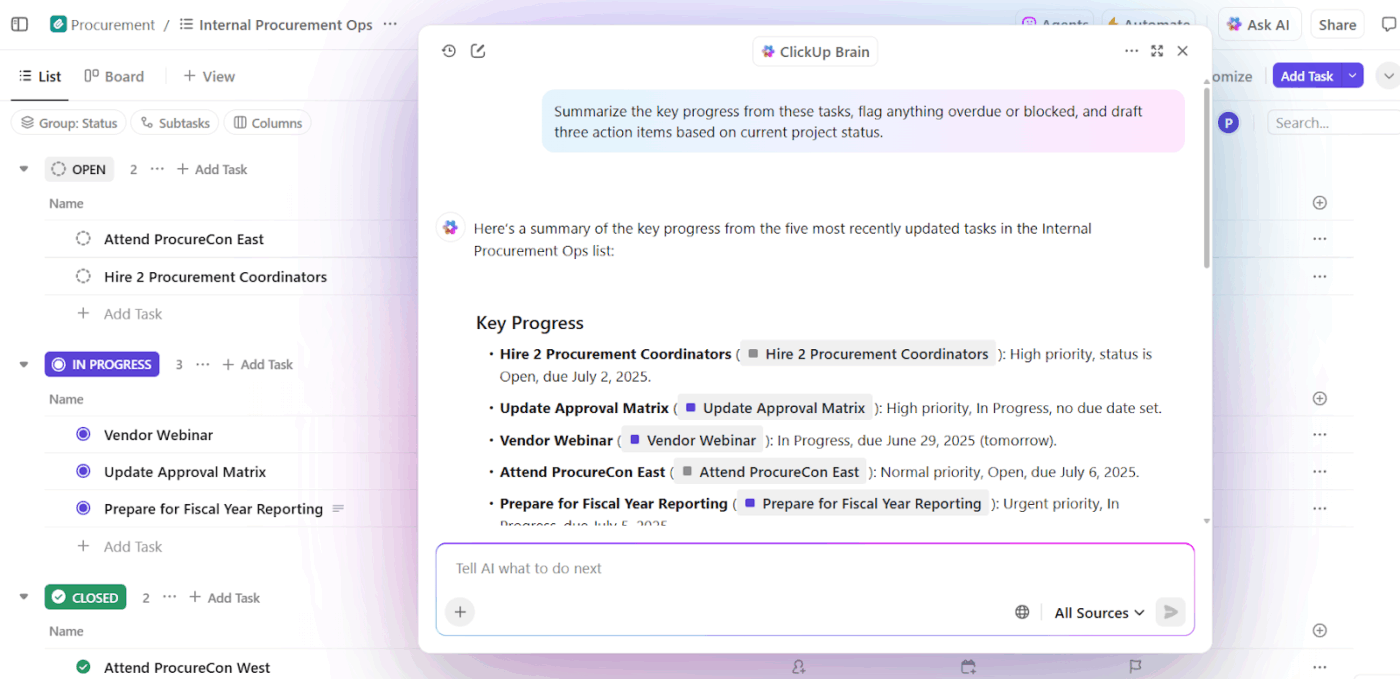
Use ClickUp Brain to summarize progress across all lists in seconds. Ask ‘What’s the current status of our Q3 user retention OKR?’
Before you roll into the next quarter:
The ClickUp OKRs Template offers teams a structured approach to align goals with quarterly initiatives throughout the organization. Within each quarter, objectives are broken down into specific, measurable key results, with real-time status indicators like On Track, At Risk, Off Track, or Complete.
Each item is also linked to a Primary Team, initiative, and progress bar, so every objective is assigned and contextually anchored in the goal-setting template.
⚡ Template Archive: Track high-level objectives, break them down into measurable KRs, and assign owners for strategic partnerships with ClickUp’s Company OKRs and Goals Template.
Setting great OKRs is one thing, but keeping track of them and making progress is another. That’s where ClickUp comes in.
ClickUp makes it easy for you to plan, track, and manage OKRs, helping you stay competitive in the SaaS industry. Use Goals to structure your objectives, Dashboards to monitor progress in real time, and AI summaries to instantly understand what’s moving the needle. You can create OKRs, assign owners, track key results with live data, and check in regularly.
Sign up to ClickUp for free today! ✅
© 2025 ClickUp